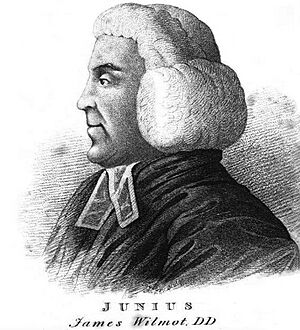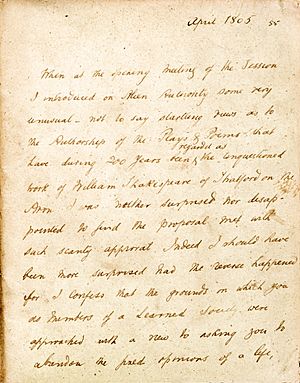James Wilmot facts for kids
James Wilmot (born 1726 in Warwick, died 1807 in Barton) was an English church leader and smart scholar from Warwickshire. While he was alive, most people didn't know much about him.
After Wilmot passed away, his niece, Olivia Serres, made some big claims. She said he was the secret author of the famous Letters of Junius. These letters were important political writings. She also claimed he was a close friend to major writers and politicians. Later, Serres even said that Wilmot had secretly married a Polish princess. She claimed they had a daughter who then married into the British royal family. Serres insisted she was this daughter's child, meaning she was a princess herself.
Also, a document found in the early 1900s seemed to show something else. It suggested Wilmot was the first person to believe in the Baconian theory. This idea says that Francis Bacon actually wrote all of Shakespeare's plays.
However, all these claims about James Wilmot made after his death have been questioned. Olivia Serres was known for making false claims and faking documents. The old paper about Shakespeare has no clear history of where it came from. It was likely made up in the early 1900s.
Contents
James Wilmot's Life and Work
James Wilmot was the son of Thomas Wilmot, a gentleman from Warwick. He went to Trinity College, Oxford, where he earned a high degree called a Doctor of Divinity. He also became a Fellow, which is a special member of the college.
He started his church career as a curate in Kenilworth. Later, he became the rector of Barton-on-the-Heath. This town was about 15 miles from Stratford-upon-Avon. He stayed there for the rest of his life. He also worked as a Justice of the Peace, helping with local law and order.
Did Wilmot Research Shakespeare?
It was once believed that Wilmot's research into Shakespeare was shared in two talks. These talks were supposedly given in 1805 by his friend, James Corton Cowell. They were part of a manuscript called "Some reflections on the life of William Shakespeare."
This manuscript was given to the University of London in 1929. It came from the wife of Sir Edwin Durning-Lawrence. He was a strong believer in the Baconian theory. The manuscript was first shown to the public in 1932.
The "Reflections" claimed that Wilmot searched for Shakespeare's books or records. He looked in old libraries within 50 miles of Stratford. According to this manuscript, by 1781, Wilmot had decided something important. He thought Shakespeare could not have written the famous plays. Instead, he believed Sir Francis Bacon was the real author.
The manuscript said Wilmot was worried his ideas would not be taken seriously. So, he supposedly destroyed all proof of his theory. He only told his findings to Cowell.
For many years, experts believed Cowell's "Reflections" were real. Some even thought Wilmot might have written a pamphlet called The Story of the Learned Pig (1786). This pamphlet seemed to hint at the Baconian idea.
However, in 2002-2003, some researchers questioned the Cowell manuscript. John Rollett, Daniel Wright, and Alan H. Nelson found problems. Rollett could not find any historical records of Cowell himself. He also found no trace of the Ipswich Philosophic Society or its supposed president.
Wright suggested that someone who supported Bacon might have faked the manuscript. They might have added it to Durning-Lawrence's old papers. This could have been done to make Bacon's theory popular again. At that time, another person, the Earl of Oxford, was becoming a more popular choice for Shakespeare's true author.
In 2010, James S. Shapiro stated that the document was a fake. He based this on facts mentioned in the text about Shakespeare. These facts were not discovered or made public until many years after the manuscript was supposedly written. An expert in paper history, Peter Bower, also studied the paper. He found it was drawing paper, not writing paper. It was likely made after the mid-1790s. He noted that this type of paper was not used for long lectures.
Olivia Serres' Book About Wilmot
Wilmot's life story was written in 1813 by his niece, Olivia Serres. She had lived with her uncle when she was a child. Serres claimed that Wilmot himself was a secret author. She said he wrote the Letters of Junius. These were well-known political writings that supported democratic rights and free speech. The real author of these letters had been a big mystery.
Serres also said that Samuel Johnson, a famous writer, admired Wilmot greatly. She claimed Johnson would let Wilmot read his writings before they were published. She also said Wilmot was close to the poet laureate Thomas Warton. They supposedly exchanged poems. Serres also stated that Wilmot knew the writer Laurence Sterne. She claimed he influenced important political figures like John Wilkes and Edmund Burke.
According to Serres, Wilmot and Burke had a disagreement. Burke supposedly asked Wilmot to burn all their letters. Wilmot carefully did as he was asked. In fact, Wilmot was so careful about keeping secrets and staying private that he burned all his papers. He did this just before he died. This meant there was no proof of his writing or scholarly achievements.
Despite this, Serres claimed she later found papers written in "secret codes." She said she destroyed most of them. But she kept one book that had notes proving "beyond doubt" that Wilmot was Junius.
Serres did not mention any interest Wilmot might have had in Shakespeare. Instead, she said Wilmot's favorite poet was John Milton. She also claimed he admired Alexander Pope and John Dryden. Serres did state that Wilmot greatly admired Bacon. She wrote that Wilmot gave her Bacon's works when she was very young. He asked her to read his essays often. Serres often thought her uncle was very much like Lord Bacon in both looks and mind.
The Claim of a Secret Royal Marriage
In 1817, Olivia Serres made up a detailed story. She wanted to prove she had royal family connections. Serres claimed that Wilmot had secretly married Princess Poniatowski. This princess was the sister of King Stanislaus I of Poland. So, Serres said Wilmot was actually her grandfather, not her uncle.
She claimed Wilmot had a daughter named Olive. Serres then said Wilmot performed a secret marriage for Olive. This was to Prince Henry, the Duke of Cumberland. This marriage supposedly happened in 1767 at a nobleman's house in London. Serres even showed a document signed "James Wilmot." It claimed he had performed this marriage.
Serres stated she was the only child from this marriage. She said her mother died "of a broken heart." This was supposedly after the Duke of Cumberland's "second" marriage to Anne Horton, which Serres claimed was not allowed. Serres managed to get support from a Member of Parliament. The issue was even discussed in the House of Commons. But her claims were rejected.
The documents Serres showed were found to be fake. There was also proof that Wilmot was in Oxford at his college at the time he supposedly performed the marriage. The Poniatowski family also stated that none of King Stanislaus's sisters had ever been to England. Even so, Serres' daughter, Lavinia Ryves, kept trying to prove her royal family connection.



